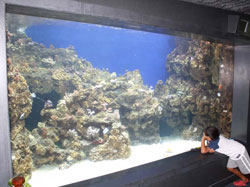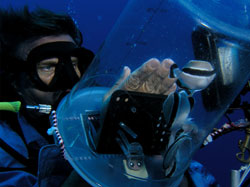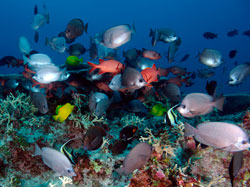
A Monumental Experience at the Waikīkī Aquarium

An eager spectator is engaged in the Papahānaumokuākea exhibit featuring a living reef ecosystem representative of that found in the Northwestern Hawaiian Islands. The exhibit also includes interactive touch screens to provide additional information on the significance of the marine ecosystem of the islands and their geological formation. Credit: Kahi Fujii
It's taken six years since its inception, but the Waikīkī Aquarium opened a major exhibit featuring the very special and rare marine life of the Northwestern Hawaiian Islands. On Thursday, August 18th, Oʻahu visitors got their first glimpse of a living reef ecosystem similar to that found in the world's most isolated islands.
The grand opening included family fun and keiki crafts such as fish-making out of palm fronds, making your own Masked Angelfish hat, and coloring your own canvas tote bag. NOAA Marine Debris, Hawaii Institute of Marine Biology, and Papahānaumokuākea Marine National Monument hosted educational booths and activities.
"This is a monumental experience for our visitors," says Dr. Andrew Rossiter, director of the Waikīkī Aquarium. "The Northwestern Hawaiian Islands serve as a home to over 7,000 marine species, a quarter of which are found nowhere else on Earth. The public will finally get to see live fish and coral specimens that until now have been privy only to scientists conducting research in the Northwestern Hawaiian Islands.The exhibit is an unprecedented opportunity to view abundant marine life from one of the most remote areas on the planet."
"We are so appreciative of the support we have had and continue to receive from various organizations. In the last year or so, we have relied heavily on the dedicated work of Richard Klobuchar, Waikīkī Aquarium coral biologist, Randy Kosaki, Papahānaumokuākea Marine National Monument Deputy Superintendent of research and field operations and Richard Pyle, Bishop Museum scientist, to physically bring unique fish and coral from the remote islands," said Dr. Rossiter.
The process of acquiring the fishes is not an easy one. After obtaining the proper permissions and permits, the team boards an expedition ship that departs from Honolulu to Midway, stopping at other atolls along the way to conduct their dives.

Richard Pyle places bandit angelfish in a clear bucket with a spring-loaded trap door that allows his hand to be inserted and taken out while keeping the fish within. Once the fishes reach the surface, they are maintained in a special closed-circuit, refrigerated seawater system on the ship. These fishes, treated ever so carefully, were then flown from Midway to Oʻahu arriving in just a matter of hours. Though an involved process, the Aquarium had a 100 percent survival rate, meaning that all specimens arrived alive. Credit: Raymond Boland
Because many of the fishes needed for this exhibit are found at depths of 200-220 feet, the collector for this trip, Pyle used technical (versus recreational) diving techniques, which encompasses the use of mixed gases including helium.
Click here to view the Honolulu Star-Advertiser Feature 8-17-2011 (2.2mb pdf).
Click here to watch the Video about the Making of the Papahānaumokuākea Exhibit at the Waikīkī Aquarium.
